#or as it will be once i actually post this. gm
Text
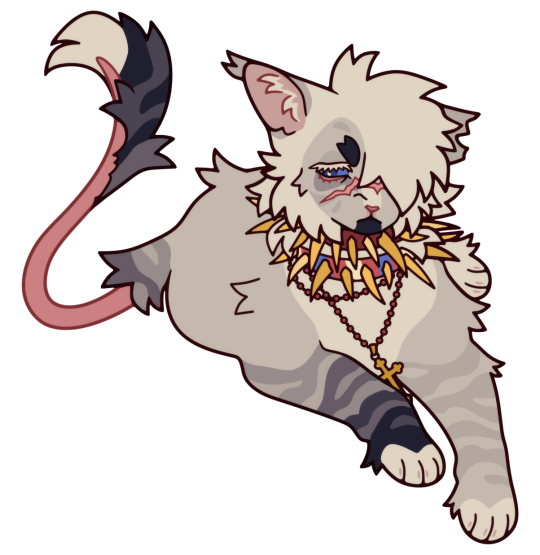
SCOURGE SUNDAY 025/???
BLESSING leader of WATERCLAN
#scourge wc#warriors#warrior cats#scourge warriors#wc scourge#scourge#scourge warrior cats#bloodclan#scourge sunday#this 1 goez out 2 the classic fanz LOL if u recognize him this is post number 3 with inverse scourge#didnt change his deisgn much bcuz to be honest i open at work tomorrow n it is. 1:30am#alwayz wanna do colored lashez but somhow i find thm... so hard.......#also evry1 keep an eye on my non warriorz blog im close 2 finally finishing a big ref commission im rllyyy hapy with#im very funny as a person bcuz i feel bad for how long it haz taken me but 4 som reason my reaction 2 tht is to. put off working on it#n thn i feel worst. repeat forevr#also might make a just stright up inverse color verison of this design somtime the patterning is fun i think tht would be neat#ok gn#or as it will be once i actually post this. gm
388 notes
·
View notes
Text
Anyways, speaking of working on games, how about some Stampede Wasteland updates;
Working on a carousing table;

Also a little table to inspire GMs when they need to whip up a last second mission;

And the highlight of this post, rules for tracking Resources and rules for tracking money. Resources first.
The goal was to come up with an abstracted way of keeping track of the more mundane supplies and stuff that PCs are going to need without having to worry about actually keeping track of things. So, behold, either you have it or you don't.
Resources
Each player has an abstract, binary pool of Resources. This covers rations, water, fuel, bullets. All the bare necessities. If it is ever in question whether you have Resources or not, roll+Hits marked. On a success, you’re out of what you need. You either have Resources or you don’t. There’s no in between.
And now for wealth. Originally, I had a pretty standard "this sort of things costs this much" and "this job might reward this much". But here's the thing, coming up with actual monetary values sucks and I hate doing it! Also, given that supplies are abstract, why shouldn't money be abstract? Internal consistency is nice.
So, two birds one stone, I ripped out the original "wealth system" and replaced it with the following;
Cash
Each player has an abstract pool of cash on hand at any given moment. The exact amount doesn’t matter. You can have No Money, A Little Money, A Lot of Money, or More Money Than You Could Ever Imagine (you cannot actually ever have this much money, bummer).
Each time you gain A Little Money, mark one slot on the track (10 slots). Once the track is filled up, you have A Lot of Money.
If you have A Little Money, you can always afford things that cost A Little Money. Same for A Lot of Money. If a situation ever arises where you might lose money, roll+money slots marked vs 20. On a success, you’re good. On a miss, step down one wealth level.
Money is tracked individually, but you can give a slot of Money to someone else if you really want. Cash rewards go to whoever is the agreed upon treasurer. Hope you trust them. If a character ever dies with wealth on them, half the number of marked money slots can be recovered from their remains, rounded down to a minimum of zero.
Nobody starts the game with any money.
Ultimately, how much money you have wasn't going to matter in the game beyond bookkeeping, just whether or not you had enough. And this subsystem represents that better. I ended up going with "roll+money slots marked" as the "modifier" to the roll because it makes some sense that the more cash you have, the harder it is to lose it all.
Still plugging away at the GM facing material, but honestly, almost all the player-facing stuff is done (and I'm going to be doing some small playtesting, before maybe opening it up some. We'll see.), and it is nice to get closer and closer to text-complete.
104 notes
·
View notes
Text
RPG Read-through: .dungeon//remastered
For a while on Twitter, I've been doing read-through threads where I post my thoughts as I'm reading through a game for the first time. I recently did the same with Snow's .dungeon//remastered, a TTRPG where you are players logging in to a dead/dying MMO and exploring the digital fantasy world. I'm adapting those thoughts here for a proper Tumblr post! Enjoy!

First up, credits! Good folks who do good work in my experience. Also, we get the first of what seems to be a common through-line here that I enjoy: an online fandom bent to this all being a sort of GameFAQ style guide for an in-universe game.
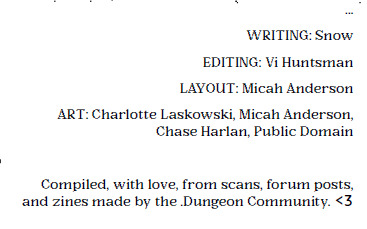
My initial impression from most of the interior spreads I've seen just flipping through it is that I really love the style and layout. I think black and white layouts are underrated generally, but it really pops here with the pixelated text/symbols and the old school GUIs.
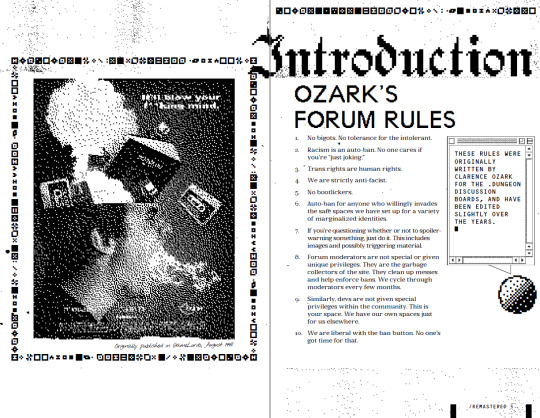
It's interesting to have these kind of "no bigotry" rules you see in many games couched within an in-universe framing. I think this more personal angle actually makes them land better for me than they typically do in games.
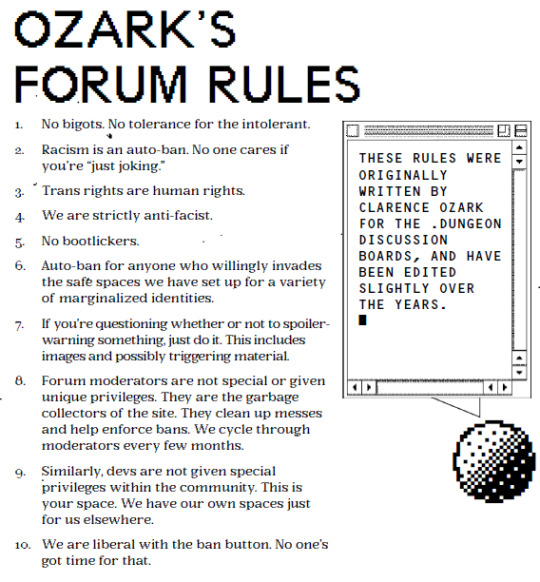
Of course, the author is still powerless to stop the players (just like with any instance of these rules, and all game rules in general tbh) BUT this is worldbuilding too, and it gives me a greater sense for the kind of in-universe fandom that's risen up around .dungeon.
Similarly, here's the game's unique version of safety tools - an in-game help menu that reworks things like lines/veils, x-card and more into the game world itself. I really like this.
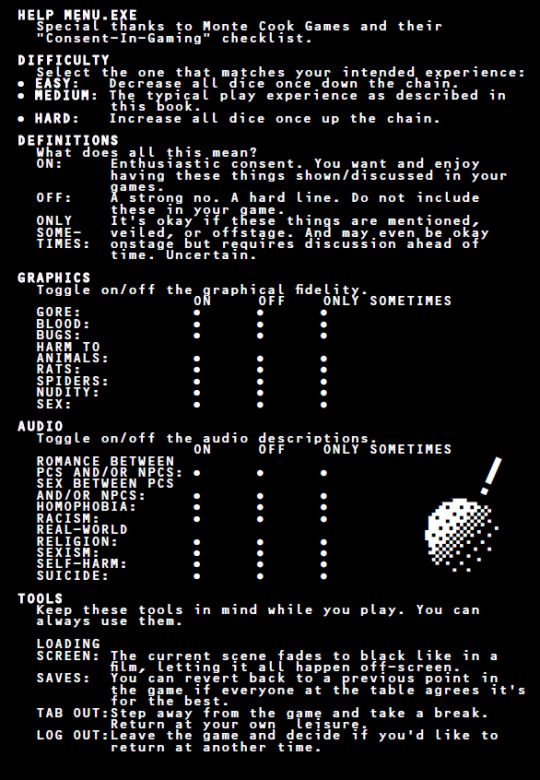
Once again, the art in this is just great. I love the Fez-like runes/symbols. My ARG brain wants to know if there's a hidden message here.

I was surprised it was jumping right into the starter adventure, Tutorial Town, but I quickly found out that this is character creation AND a starting area/adventure all wrapped into one, video game-style, and that's so cool.
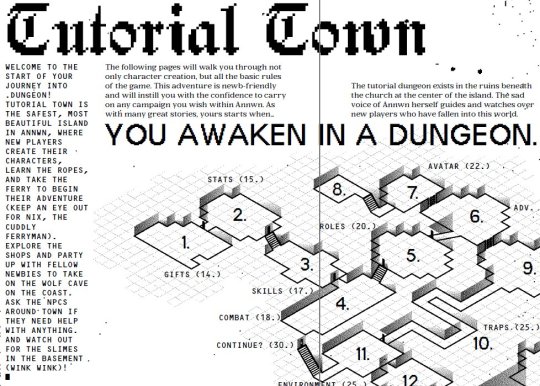
Each room of the starting area introduces a step of character creation. It's interesting that stats are based on real-world (not you the player at the table real-world but your PC at the "real-world" computer playing the game) ability. Your game knowledge, response time, etc.

As a long time Dota player, I also just really enjoy that the saving throw-like stat here is TILT. I have tilted many times and known many of my teammates to tilt regularly. Just fun to see that phrasing in a TTRPG.
There's more of the in-universe real-world player here than I expected coming in. Definitely has some really intriguing potential. I do wonder though if the intent is to be playing a "real-world" level character or if you are "playing" as yourself at that layer. Both would work.

Monster statblocks. Easy to parse and straightforward to run as the GM (tho at time the layout does have one two many things laid on top of one another that can make them hard to read at first glance - like where "GOBLIN" is here):

Health here is SYNC, and it's shared across the whole party - I'm interested to see how that full mechanic plays out and how it may affect play.

Reaction rolls. I'm surprised to see them given the video game setting, cus mobs in MMOs just always attack you. I've gone back and forth on it with my video game-inspired TTRPG. Don't think it's a bad choice, just one that means the game world is more than a usual video game.
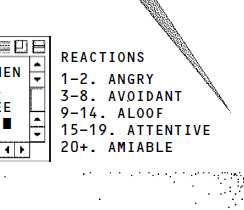
So you have your real-world level Job (based on your characters' out of game job) and your in-game "Role" which follow the classic "holy trinity" of MMO design:
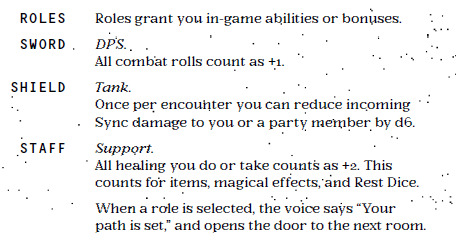
PCs and monsters can team up to attack and can forego damage for stunts - potentially fun/interesting moments happening from that. Monsters deal dmg to SYNC but only per type is interesting, means a crowd of one-enemy is more a long trickle of damage than an overwhelming burst.
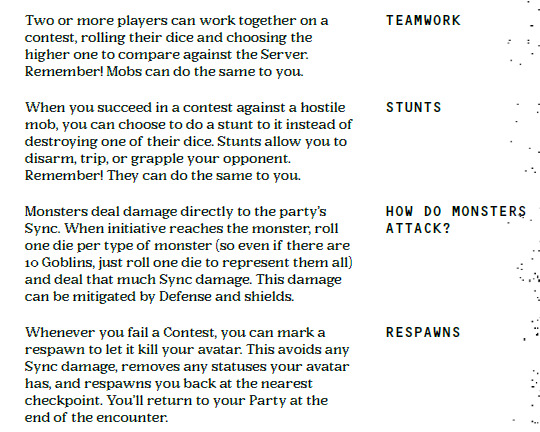
Not knowing the ramifications of SYNC damage yet, I'm not sure what the Risk v Reward looks like for Respawns but it's intriguing. Letting your avatar die to keep the party in a stronger position overall (but being able to re-join after a fight) is definitely unique.
This is another fun room (and I like that other than saying late 90s/early 2000s it leaves appearance options open). I am not sure where to find the starting origins tho (they aren't on this spread and there's no page reference). Sadly, the PDF isn't bookmarked either, it seems.
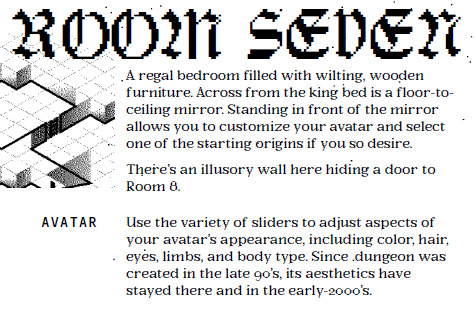
This feels like a smart roadblock to place in player's paths early on. It's unlikely they'll have a lockpick at this point so really, it's about getting players into that creative mindset. What is in the room for you to exploit? What gear do you have you can use in a new way?
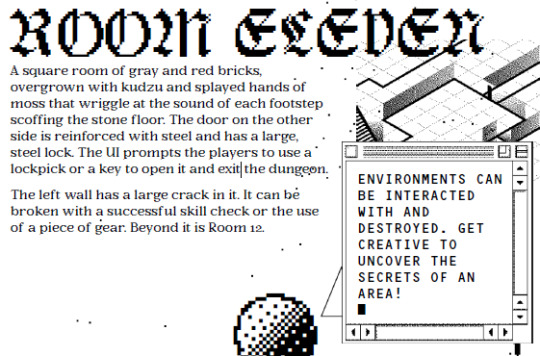
Might seem basic, especially to the OSR-experienced out there, but you'd be surprised how many players don't have experience with thinking more freeformly about the game in this way. No fault to them, most trad games condition you to use your PC's abilities/skills as a menu.
Another cool interaction between the layers of the game here (tho I do wish they all played more off of something more than just the tarot card being in the real-world layer). Still wondering if most folks play as themselves or as a real-world level PC.
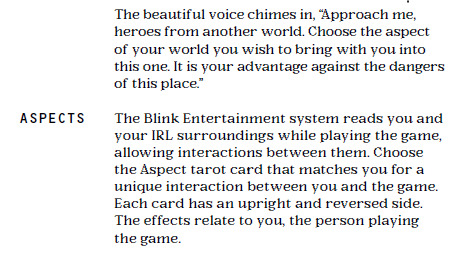
This is interesting. I wonder if there is going to be a real-world layer to play or if this is meant to be the amount your party can heal between sessions of play (like when the actual real you stops playing in actual real life - this meta layer stuff is tricky to communicate).

I like this - a very short and sweet travel system.
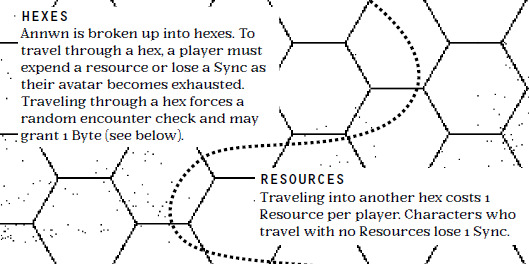
I continue to love this art. Also, this tease here around dual-wielding requiring the discovery of new Roles out in the game world somewhere first is really enticing (I added the highlighter there btw).
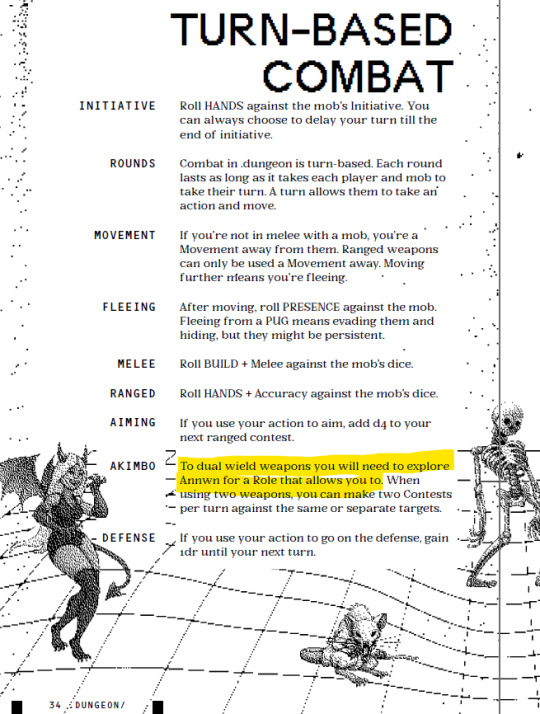
This is fun - there are both in-game NPCs and PUGs which are other real-world players' in-game avatars. That extra layer to those types of NPCs is really fun and them running the gamut of fully out-of-character chatting to being hardcore RPers is fun to consider.
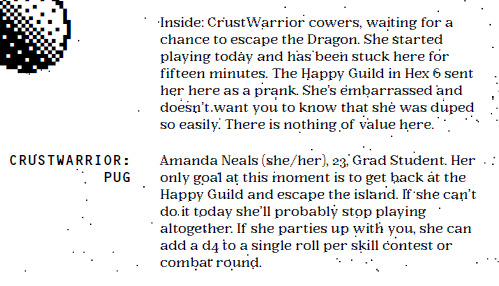
Whenever it leans into the digital world aspects, I'm super into it. Very much my kinda thing. I do wonder though how often players can swap their Roles. I don't believe I've seen that said yet - my inclination would be once on the fly (like Final Fantasy's Job systems).
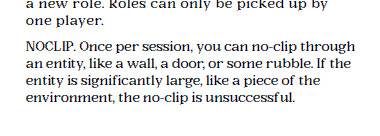
And if these various layers weren't enough, .dungeon also features in-game collectible cards that are sort of enchantments and buffs. I wonder if my real-world level character can spend real money to buy Bytes to buy more packs from a merchant in town? lol
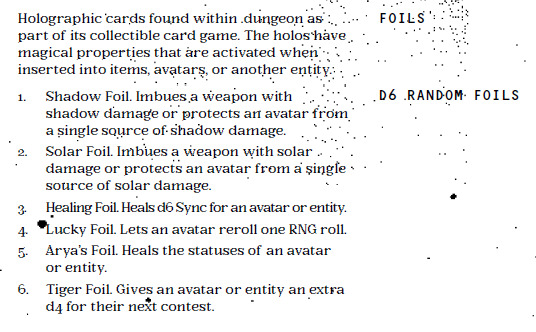
I won't spoil/detail too many more of these but these kind of fun (and common to video games but rarely seen when thinking of the world of a game or the intended way to play) moments are really appealing. Also, this game has Goons in it. Oh no.

Now I'm thinking the intention is the "real-world" level of play should be the real actual you, the person playing .dungeon the TTRPG (as opposed to a real-world level character still within the fiction of the game) since stuff like this would be tricky to track. Cool item!

Tutorial Island is cool, a good blend of char creation, intro to what the game is, and just a fun adventure with a session or more of play to it. I'd have to run/play this to really see but I find the Sync being tied to essentially your real-world session length interesting.

This stuff is cool and leans into that meta/fan-level play that only comes out of these big community-driven games, both MMOs but also things like Dark Souls.

A lot of these kind of possible secrets come as comments in the text, possibly just to inspire the GM and to get players interested in ways that the table can build out on their own over time. So far, I don't see some of the more esoteric secrets to be laid out (which I like).
The rest of the book, as far as I've seen, is lots of resources, gear tables, monsters, etc. to build out the game after player's leave Tutorial Island. The game world here has that anything goes Final Fantasy bent to it. There's swords & wagons, but laser guns & skateboards too.
The setting here is also explicitly queer (mostly seen so far in the "real-world" PUGs) and includes things like sex workers and other elements that it maybe could not have had but that would certainly lessen the richness of its world, the fandom presented throughout, etc.
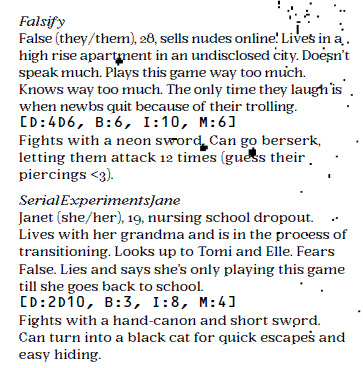
The spellcasting uses the in-game money as mana points essentially. That's a cool way to limit spellcasting and motivate player's, especially spellcasters, to get out there and make some $$$.
Okay, here's the real-world explanation I was waiting for (after the in-game gear lists and such). This is cool - it's fun to have a real-life layer to this and to have the game's world support that sort of dropping in and out, doing things outside of a full party session, etc.
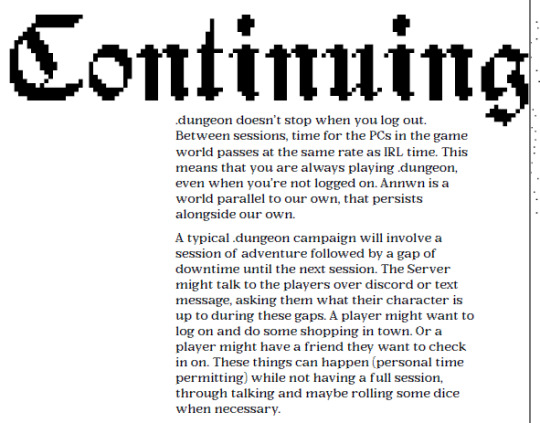
I know a lot of folks do this with ongoing campaigns anyway, but this is one of those fun things to include here to build that in as an expectation in play. You have your raid nights with friends and you have your little solo sessions after work where you sell your loot.
Now, the rest is a nice collection of random dungeon, NPC, settlement, hexfill tables and more. Everything you'd expect from an OSR-like ruleset but occasionally with some fun added meta-layers.
Players getting a quest from an in-game Moderator and then being able to become a Mod themselves is a really fun idea and something I could envision becoming a long-term goal for one or more players at a table. The threat of encountering an Admin is scary as well!

To finish it up, we've got a cool AASCII-style character sheet, complete with MingLiU-ExtB font (my beloved)!
And that's .dungeon//remastered! I really enjoyed reading this, and I think it has a strong core that's really enhanced by its real-world interaction layer. Gonna put this on "Play Soon" list. There are some smart rules in particular I'll likely steal for a future project.
.dungeon//remastered is available digitally NOW with, I believe, physical copies coming soon. I backed the Kickstarter to get this digital version. CHECK IT OUT HERE!
177 notes
·
View notes
Text
oh my goddddd I am so so so not normal about the concept of the endbringer truce, even more than I am about kill orders (and I am very not normal about government licensed assassinations).
the endbringer truce was ratified. and cauldron was obviously responsible for it crossing from cultural phenomenon to an actual set of laws, but to push that in the first place they had to make sure the concept was deeply important. and it is, it's become a cornerstone of both caping and just being a citizen of earth bet.
that leads to a lot of different ways to look at the concept. there's the cynical outlook, the bitterness the ordinary citizen feels when villains get away with running roughshod over them just because they show up to endbringer fights. heroes have their own flavor of this too, because there's a very real sacrifice of morals that comes from working with a nazi. even if people agree the ends justify the means here that doesn't mean those means don't cost you something. no hero on bet has clean hands, and they know it.
then there's the emotional outlook, where all the feels congeal. I'm such a sucker for humanity banding together, even in the face of hopeless odds, and the endbringer truce makes me tear up when written right. a week from now they'll be at each other's throats but in the moment, with levi or behee or simmy looming above, with the wreckage created surrounding the aftermath, villains and heroes work together. it's beautiful.
and then there's maybe my favorite aspect, the comparative outlook. how starkly the differences in mindset are between earth bet citizens and those of other worlds enchants me. that society has normalized setting aside grudges for the sake of survival in a way that most people can't, because the emotional hurdle is too much to pass even if they get the logic, and stories where that shows are just the best.
I read a post-gm isekai fic where taylor's gambit to rally a group of people against a bigger enemy failed, and that moment stuck with me because she specifically noted that it failed since she assumed the world would have responded like bet would have, and that even baseline humans from her home dimension would have understood the plan. and y'know what they fucking would have. because everyone agrees you Don't Fuck With The Truce.
having to actually explain first why the truce is important just did not occur to her, the argument was focused on why the enemy was obviously truce-worthy. but tay listed out the core concepts and people Did Not Get It and that was such a wild bit of culture shock from her perspective. being too cowardly or morally uptight or selfish to put aside grudges so you can survive gets culled real quickly on bet, but in that new world it was the norm.
it also let to a hilarious moment where she stone cold maimed (or maybe straight up bodied I don't remember) a guy who broke truce and to her surprise people were absolutely horrified. for once tay was not actually trying to deal psychic damage and someone sane could agree that everyone else is overreacting, because maiming or killing people who break truce when birdcages or life sentences aren't available is a completely reasonable response on bet!
I love exploring culture shock and reactions to it in the context of earth bet citizens on other worlds, and the endbringer truce is one of my favorite avenues to do so. it's status as a cornerstone of that society led to a fundamental shift in mindset that truly I am very very very not normal about as evidenced by this nine paragraph post about it.
94 notes
·
View notes
Text
D&D is actually pretty good
Or how I learned to stop worrying and love the dungeon crawl
I lied. This last instalment to my post actually has enough meat in it to be two posts at least, simply because I realized that "Challenge Mode is good, actually" and "if that's unacceptable to you, here's some ideas" are incredibly broad topics, so what was supposed to be one final post will actually be at least two if not three posts.
In previous instalments I've talked about what makes D&D a game that supports Challenge Mode and an ill fit for Story Mode. Once again, you can find the previous instalments here:
1. Terminologie
2. What is it that D&D actually do?
3. Misaligned Expectations
And I'm once again tagging this as #the big damn post.
4. Challenge Mode isn't that scary really
D&D played mostly in Challenge Mode gets a bad rap because of unbelievers who think that a game should have a wider narrative arc and because it is often associated with the dungeon crawl which is reviled even among people who play the Dungeon Game. I'm here to tell you that a game played mostly in Challenge Mode can be rewarding, not only in terms of gameplay but also narratively.
The idea that a game played in Challenge Mode needs to be a dungeon crawl is first of all false. For a game to technically count as Challenge Mode the focus simply needs to be on the players overcoming challenges on their own terms inspired both by their sense of exploration and their desire to get more goodies. Goodies are nice. It very much taps into the basest desires of a D&D player: the desire to see the Numbies on the sheet Go Up, and to get Goodies. It's basically a slop-delivery mechanism in the guise of D&D, except good.
Generally there will be a separate adventuring zone that separates the game into adventure and downtime, and while the most classic example of this format is the town that acts as home base and the dungeon that needs to be explored in multiple successive sojourns, that need not be the case. The location could be a wilderness that needs to be explored, a haunted castle, an abandoned city. Heck, there may not even need to be a strict division between the downtime location and the adventure location. An urban powderkeg can be just as supportive of a Challenge Mode game as a megadungeon.
The important difference between a Challenge Mode game and a Story Mode game is that in a Challenge Mode game no special effort is made towards trying to tell a specific (often GM-authored) narrative. Characters will also need no extrinsic motivation besides the player-driven desire to play with all the toys in the sandbox. While character backstories are nice, in the context of a Challenge Mode game the exploration of a character's backstory takes the backseat.
This does not mean that a Challenge Mode needs to be bereft of narrative content. The challenge still takes place in a fictional place where the players are in charge of their avatars and that place can be made to feel real. In fact, one possibility is for the discovery of the adventure locations' history to be an important asset for the player characters: discovering historical tidbits about the location may reveal clues that open up future challenges. Players are still encouraged for engaging with the fiction.
And that's just the thing: while there is no grander narrative being told than, say, a group of adventurers exploring a grand location, overcoming its various challenges and engaging in its history, there is not only an emergent narrative (the actions the players take) as well as the fiction of the place that the players are exploring. The GM does not need to worry about keeping characters alive through contrivance to maintain narrative integrity, because even a TPK is not a failure state: it simply means creating new characters and getting back to the exploration. Since the player characters were not a special group who have been pursuing the Plot since day one, it is easier to explain them being replaced by another group. (surely the first group weren't the only ones exploring the location?)
Also, you know how you hate having to work around the schedules of half a dozen different people? Did you know that without a narrative continuity that will start to feel contrived if people make a habit of dropping out of the game you don't have to worry about that? Challenge Mode games are particularly conducive to open tables or the legendary West Marches style campaign. (essentially an open table but on a grander scale, if you want to know more check out this writeup)
Obviously this type of gaming isn't for everyone and it's good to be up front about that: some players will want the additional narrative context and characterization scenes. And it needs to be said: Challenge Mode games are not alien to characterization, but it is probably of a different type than most players expect. Players should expect to express their character within the context of the challenges, not in a separate mode of play that takes place outside of rules-mediated play.
Challenge Mode games absolutely still benefit from players putting on weird voices and pretending to be their characters, but those weird voices and characterization are now expressed in the context of a challenge game. This still leaves room for emergent narrative, including relationships. There's also no reason to rule out characterization scenes as part of the downtime, but in general the loop should lead the group back into the Adventure as soon as possible. Periods of downtime can be easily handled outside of precious time at the table.
And that's pretty much it! Challenge Mode is not, despite popular belief, devoid of narrative. That's just propaganda by Big Story that wants to sell you more Story. Playing the game of D&D to its strengths, allowing players to make informed mechanical decisions and giving players the agency to engage or disengage with challenges on their own terms can be extremely rewarding. And it shouldn't be seen as in any way inherently lesser than Story Mode. Arguably, D&D as written is much more conducive to Challenge Mode than to Story Mode.
And yeah, this definitely needed its own post. The next post is either going to be the final or penultimate one, and in it I will discuss games that I feel have better mechanical support for narrative convention than D&D, with an eye towards which elements of them may be easiest to borrow into D&D.
91 notes
·
View notes
Note
about Richter and Olrox AU
some scenarios i would love to see if you interested :) (i love your AU's idea!! i needed it honestly)
1. Lets assume that Richter managed to escape once and even not far away but in that short time he managed to hurt himself (broken leg, arm or nasty bruises) and Olrox, who quickly finds him anddd... I leave the rest for you to complete bc i dont wanna interfere to your Olrox's character
2. Richter is nearly bitten by another vampire during a ball
3. Richter has a breakdown over being estranged from his mother and seeks comfort in anything other than Olrox but eventually turns to him
4. Frequent nightmaresss
5. Another Richter escape attempt ending in failure
thats all :3 feel free to add anything!!
gn/gm
(Young Richter gets captured by Olrox as revenge: a bittersweet found family au introduction post)
Ok first of all I gotta say that I’m in LOVEEEE with these prompts! I’m gonna do all of them eventually in no particular order, ESPECIALLY the nightmares bc that can be a whole one-shot (plz let me know if you want it, guys) but let’s start with the scenario nr 2 🤭 buckle up because this is gonna be a long one!
.
.
Olrox had a nagging feeling in the back of his head that told him something was off, and he couldn’t dampen the voice of anxiety that told him to check up on his little companion.
The vampire ball was an event even the Aztec could at times barely get through, so it had been no surprise that Richter Belmont was dying from boredom. He’d been afraid at first, alarmed around immortals in puffy gowns and tall wigs, but Olrox had made it clear, both to the boy and to the other guests that no hair would fall off his head.
Some hours later, Richie settled on a bench in the garden and promptly passed out, using his newly bought navy blue coat as a pillow. The vampires awwed at the cuteness of Olrox’s "pet" (oh how that title ticked him off), but eventually left him alone and he’d been napping somewhat peacefully since, or, at least, ten minutes ago…
For Richie wasn’t there now, and the man’s lips wouldn’t crease into a sneer, if not for one simple detail.
The coat was lying on the stone pathway. The same coat that Richter came to cherish in the short time he’d been in it. “Never wore anything so expensive before” The child told him, so it made no sense at all that he’d leave that piece of clothing as if it was forgotten.
Something is wrong, the voice kept whispering, you need to find him as soon as possible, it pleaded; you have to protect him. You can’t loose him too.
Olrox cursed at how easily fear of loss possessed him, as he took the coat and, using his inhuman sense of smell, scoured the garden. His eye twitched when a familiar scent led him to a labyrinth.
He’s a kid, the vampire kept telling himself, children do foolish stuff all the time. He was just feeling bored. Deep down however, he knew it was a horrible lie. Richter was a kid, but a clever one, and a descendant of a vampire huntress. He wouldn’t get himself into a vulnerable position.
Olrox’s eyes widened. Not unless he’s trying to escape.
“Fuck-let me GO!” He heard a barely audible scream. It was far, but undoubtedly little Belmont. Aztec wasted no time turning into a cloud of black smoke, traversing above the green labyrinth and towards the sound.
“I knew you’d try something you little brat. Sort of glad you did, actually. Always wondered how Belmont blood tasted.”
“No…you won’t drink my blood. You can’t!”
“And why not?”
“Ngrh-“ A choked cough was heard and Olrox picked up a wind. “Olrox will shove those fangs down your throat!”
“Right, the dirty mutt. As if he could ever rival me.”
Olrox felt his smoke turn into sharp scales as a growl escaped his throat. He was close. So close.
Where are you, child?
“N-NO! STO—STAY AWAY—OLROX!!!”
The Aztec had that vampire seized before he even knew it. The world turned red for a moment, and when he woke up, there as a pathetic, blood-sucking immortal crushed in the vice grip of his tail. Reverting to his human form, he found Richie lying on the grass, grasping at his neck and coughing. He was at his side in an instant, picking up the small thing and holding him to his chest.
“Breathe, Richter, breathe…” Olrox spoke, rubbing Belmont’s back.
“He—that asshole tried to—” Richie spat between coughs.
“I know, but he has been dealt with. He’s done.”
Richter tried to look at the bloodbath, but Olrox pressed him back into the fabric of his cravat, now stained with tears. Surprisingly however, he did not care one bit. Fabric was just that; fabric, however intricately made. It could never replace a person.
“You….you came…” Richie then uttered, in disbelief and on the verge of tears.
“You called for me.” He answered, carding his boy’s curls.
“…I—“
“Tried to run. I guessed.”
“…are you angry?”
“I probably will be, but not now.” Olrox smiled, picking up the child. “For now, you being unharmed is enough. I’ll scold you in the morning.”
Richter smirked, though sadly. “Is the party over?”
“No, but we’re leaving. Now.”
“Oh thank god!” Richter whined, no fear or sadness left in his voice. “Let’s go, I’m starving!”
#castlevania nocturne#castlevania au#castlevania fanfiction#castlevania richter#nocturne richter#richter belmont#richter#castlevania olrox#nocturne olrox#olrox#olrox/mizrak
121 notes
·
View notes
Note
What makes this game unique from other mystery games?
Eureka has plenty that makes it stand out, from its tactical approach to combat, to its approach to the supernatural and non-restrictive character creation, but the thing that makes its investigation stand out from that of other investigation games is probably the Eureka! mechanic and its overall approach to failed investigation rolls*.
*An “investigation roll” in Eureka is any skill roll used to investigate, there is no “Investigate” skill, every investigation roll will use the skill on the character sheet that is most relevant to whatever evidence the investigator is investigating. So, in a way, every skill is the "investigation skill". For instance, you would use the Firearms skill to try and guess what calibre of bullet left these bullet holes, even though that is also the skill that is used for your accuracy when shooting guns, and how quickly you can reload.
Now, we don’t want to make a blanket statement because our dev team has not played every investigative TTRPG, but in the ones we have played, there have been a couple of consistent hang-ups. In Call of Cthulhu for example, when you miss a clue due to a bad roll, you’re just shit outta luck. This isn’t to say that Call of Cthulhu is a bad game, Eureka actually takes a lot of influence from certain parts of it, but sometimes a single bad roll at a crucial time can grind the adventure to a halt.
The Eureka! mechanic is (one of) our answers to this problem.
As the investigators fail investigation rolls*, they accumulate Investigation Points. (They actually accumulate Investigation Points even if they succeed, but you get way more of them for Failures). When a standard investigator accumulates 15 Investigation Points, they gain 1 Eureka! and their Investigation Points reset to 0. More powerful supernatural characters must accumulate more than 15 points before they get a Eureka!, but that’s a different post.
A Eureka! is a valuable resource that can be spent on a couple of different benefits, and one of those is to retroactively turn a single previous Failed investigation roll* into a Full Success, giving that investigator all the information they would have figured out if they had succeeded in the first place. This can be a significant mystery un-stumper when the party is stuck at a dead end, without the GM needed to artificially give them a hint—it’s not a free pity clue, they earned it by being thorough investigators up to this point even if they got some bad rolls.
This can act as a sort of “rubber band” mechanic, only springing the investigators forwards if they fall far enough behind to need it, so to speak, and only on their own terms, so they don’t feel like the GM just gave them the answer because they suck too much.
This doesn’t mean that Eureka: Investigative Urban Fantasy is an easy game for babies where the players never have to worry about failure, however. You only get 1 Eureka! for about every 5 Failures, and its combat can be pretty hardcore. Like Call of Cthulhu, the investigators are mostly just normal people with no special resistances to knives or bullets. If you shoot them once or twice, they die, and there’s no coming back. Not only does this fragility encourage a generally more investigative approach to dealing with threats, it can also be used to reward good mystery solving up to the point of the final confrontation. The Eureka! mechanic rewards investigators who have not needed to spend their Eureka!s on gaining epiphanies from previously failed rolls by the fact that they can also be spent to throw an extra die into a combat roll—or any other life-or-death roll, such as leaping to safety from a burning building or a Stealth roll when hiding from dozens of armed goons. 3D6 (dropping the lowest) can give a crucial boost to that one 2D6 roll that your character has to stake his life on.
Now, you don’t have to play a fragile normal human investigator, you have the option to play as a more robust investigator, like a vampire for instance, who can easily shrug off most forms of physical damage so long as they don’t overdo it all in one place and take some time to regenerate in between bouts of getting shot, but what those kinds of investigators gain in toughness and supernatural powers, they pay for with supernatural weaknesses. The vampire in the party may laugh in the face of small arms fire, but get knocked down a few pegs when faced with her greatest challenge yet: Figuring out how to get a direct and in-no-uncertain-terms invitation into the house without saying “I am a vampire, the owner has to invite me in.”
And no, she can’t just ask the rest of the party for help, if they find out she’s a real vampire, that’s nine-times-out-of-ten going to be much more shocking than whatever evidence they were going to find out inside, and possibly even implicate her in several other, much more gruesome murders that nobody ever managed to solve..
The Eureka! mechanic is also used in Eureka: Investigative Urban Fantasy’s équivalent to ‘leveling up’. At the end of an adventure, investigators can spend 2 Eureka!s to add 1 skill point to a skill. Eureka!s disappear after the mystery is solved, so you might as well use them if you have any left over, but if you’re saving them up by choosing not to spend them in a moment of real danger, that’s a bit of a risk, and could cost the investigator their life.
This also works as a bit of a “rubber band”, as investigators who increase their skills will fail less rolls, and thus gain fewer Eureka!s, slowing down their level-ups each time so they don’t shoot ahead of everybody else in the party without having to have a scaling system for experience points.
(Leveling up is an optional rule, however, and it is one that we in our group actually much prefer to play without, because we prefer more episodic or one-shot adventures where we frequently swap characters each time. Because skills have limits to how high they can go, a ‘level 0’ investigator can actually be just as capable as a ‘level 10’ investigator at any given thing, the ‘level 10’ investigator will just be good at more things.)
102 notes
·
View notes
Note
Found your blog by chance, seems like a very cool concept!
ʕっ• ᴥ • ʔっ🫖🍵
I wonder if you have played Warhammer Fantasy RPG, and if you have any thoughts on it, or who you would recommend it to
bonus question, any rules light one session RPGs with ready example scenarios you'd recommend?
Hello there! I do not have any experience with Warhammer in any of its forms, unfortunately. The closes I’ve gotten to experiencing anything Warhammer is the actual play episodes hosted on Fandible. I’ll post links to each of their episodes below.
Only War | Black Crusade | Age of Sigmar | The Black, the Grey & the Skaven | Wrath & Glory
Now, let’s see if I can do anything about the second half of your request!
Theme: Rules-Light Single Sessions.








A Complicated Profession, by Always Checkers Publishing.
A Complicated Profession is a light-hearted sci-fi TTRPG for 3 to 5 players. It's a one-shot that usually lasts a few sessions.
What do bounty hunters do when the galaxy no longer needs them? In this game, they start new careers hosting intergalactic cruises!
Reunite your disbanded crew of jaded sidekicks, shabby droids and shady accomplices. Then pick a hosting role and start a new life together.
While it may last a little longer than one session, I’m really excited about A Complicated Profession, as my game group will be playing it in about a month or so! Character creation is something of a fill-it-in mad-libs style process, which I can foresee being pretty quick and easy to set up. The tone of the game is really lighthearted as well, which I think is a great thing to look for when playing one-shots, especially if you’re playing games with folks you don’t know very well. I I don’t know game doesn’t have a predetermined scenario, but the focus of the game itself is pretty narrow, so I think it would be pretty easy to figure out what kinds of obstacles your retired bounty hunters will be up to.
Never & More, by Small Stories.
You are the newest recruits of The Society of Ushers, an occult secret society. Your mission is to prove yourself to your superiors, master the rituals required to move up a rung, and learn how to talk to ravens. Your direct superior and teacher, the Belfry-Devil, has finally deemed you suitable to circulate by yourselves amongst greater society, trusting you to remain faithful to the Ushers in the face of attempted poaching, targeted seduction, and superior parties.
This is a simple example of the kinds of games that exist in the Lasers-and-Feelings family of games, all designed around the concept of two core stats that tell us about your characters’ strengths and weaknesses. Many L&F games come with a few quick steps to create your character, a specific setting or mission, and a series of roll tables to help the GM construct a threat and series of obstacles. If you like rules-light games that are quick to read and occult settings, you might want to check out this game.
For Moria, by Luis Lasbelin.
With the Balrog dead, the hope of retaking Moria is more alive than ever. Thousands of dwarves gather from the great fortresses hidden beneath the mountains with the sole purpose of fighting to reclaim the once great dwarven stronghold.
For Moria uses the Breathless game system for games of terror and tension.
Breathless games are meant to put your characters in heavily dangerous situations, with resources that are guaranteed to run out. Because of this, I think they are a good fit for one-shot games, because there’s always the chance that your character meets some kind of doom. Because this game is about dwarves retaking Moria now that the Balrog is dead, I’d say that the setting does a lot of heavy lifting, assuming your characters are familiar with Tolkien’s Middle Earth. Definitely worth checking out.
Wolf Head, by A.C. Luke.
The King is just. Rather than execute you, he cursed you with the head of a wolf. Instead of death, you were exiled to be hunted for the rest of your days.
But now, the King needs you, or someone like you. There is a great crisis threatening the realm. If you were to solve it, he would remove the curse, pardon you of your crimes. What would you be willing to do for absolution?
WOLF HEAD is a dark fantasy tabletop role-playing game about medieval fable and what you will, and won't, do to be let back into the fold. Players take on the roles of wolves, criminals cursed with a wolf head and banished from society. You have become defined by your crimes—did you commit murder, foment revolution, speak heresy, or love the wrong person? And will what you did help or hinder you in clawing back what they took from you?
Wolf Head looks to have the capacity to be either a one-shot or take place over a large campaign. The game is meant to be zero-prep, which means that you can get a game up and running in no time, and the structure of quests means that you can start a one-shot with a specific quest that ends the session once it’s been accomplished. I don’t own this game, so I’m not sure if it comes with pre-written scenarios, but if it doesn’t, I’m expecting some tools to help you create your own quest pretty quickly.
Escape from Dino Island, by Sam Tung & Sam Roberts.
Escape from Dino Island is a thrilling adventure game about intrepid heroes trapped on an island overrun with creatures from a lost age—dinosaurs!
Players take on the role of everyday people who are brave and competent, but also in over their head. The game is designed to help you create the kind of stories that are full of action and suspense, but in which fighting is rarely a good option. Will you escape with your life? And what kind of person will you become in your quest to survive? There’s only one way to find out…
As a one-shot PbtA game, Escape from Dino Island starts you with a pretty tight premise: you’re trapped on an island populated with dinosaurs. Your characters all have different strengths that can help them get off the island, but one thing you have very little of is time. This is another story-first kind of game, but unlike other PbtA games, which require multiple sessions to tease out all of your character conflicts, Escape from Dino Island is meant to be played in one sitting, which means that any advancements available to your characters are expected to show up before the end of the first session.
Operation: Final Monarch, by poor students.
Operation Final Monarch is a one-page Tabletop RPG for 4-6 players. One player will act as the GM, providing obstacles, portraying passengers, and describing the Watchful Luftrahmer. You play as Infiltrators, spies from the fallen countries around Arstarkan. Your final mission is to kill Aleksander Von Korte.
When situations get risky you gamble with danger and can always push your luck to try to succeed in any situation. Be careful not to roll a 1 though, as a devastating consequence will soon follow. Use can also use your leverage over the passengers of the Watchful Luftrahmer, asking them questions they don’t want to answer or enacting your special abilities.
When it all comes crashing down you will have to reveal your secrets to the other players. What do you really think about them? Are you secretly in love or hold a seed of resentment?
I keep an eye on one-page rpgs because they tend to be good candidates for single-session play. With only a few rules and not much room for character advancement, these games focus on giving you the basic premise of the game and the tools you have to play through it. Operation: Final Monarch gives your a very specific goal - assassinate Alexander Von Korte. You’re given a bottle setting to play this in as well - on Alexander’s blimp. I’m really interested in this game because it knows exactly what kind of experience it wants to give you, and it’s succinct and well laid out, which means that learning how to play isn’t that hard at all!
All Hands on Deck, by Alice V.
A gm-less, storytelling, Descended From the Queen game for three to six people about a ship, its crew, and the sea they sail on. It is a game about the relationships between those people, about relying on each other, about being an individual in a team.
I wanted to spotlight a Descended from the Queen game because these games have a very unique mode of gameplay, which makes them really good for one-shot play. These games usually consist of a series of prompts attached to a regular playing card deck. Each turn consists of pulling a card from the deck, and answering the prompt related to it. Descended from the Queen games tend to be rather introspective, focusing on relationships and the ways they can affect our perceptions of events. The scenarios are also tied to each individual game, so in All Hands on Deck, the scenario involves a ships’ crew on a voyage, and the conflicts that may exist between different members due to the relationships they have to the Captain and each-other.
This Ship Is No Mother, by Thomas Manuel.
This Ship Is No Mother is a game about people in space, working jobs that are probably going to get them killed. Inspired by movies like Alien and games like Mothership and Dread, this is for fans of tension, creepy-crawlies, and general horror. Mechanically, it's a card-based Forged in the Dark game, first in the series of games currently called the Cardsharp Sonata.
In this game, players start with a full deck of cards and as you play, that deck will run down. When the deck ends, there is a climactic moment of panic as one of the characters is going to do something stupid and get themselves (and maybe everyone else) killed.
I got a chance to play this game with the creator last year and it really delivered! This Ship Is No Mother was originally designed as a way to run Mothership scenarios using a narrative system, with a time limit built in due to the fact that it uses cards instead of dice. You’ll use cards as resources, and since there’s only so many in the deck, you’ll run out of them one way or another. If you like suspense and alien horror, this is definitely worth checking out.
Games I’ve Recommended in the Past
Koboldly Go, by CoffeeSnake Studios.
Lady Blackbird, by John Harper.
Something is Wrong With the Chickens, by Elliot Davis.
The Great Soul Train Robbery, by Cloven Pine Games.
Faewater, by A Smouldering Lighthouse.
40 notes
·
View notes
Note
hey gang! me again (from /post/741038774641983488, bitching about the two coworkers and the filthy deli slicer), and i guess we couldn’t go three days/two shifts without more bullshit from J1! as i write this it’s currently the morning after the shift described below. thankfully, i have the day off today, due to a prior appointment, so i might be able to wind down again before going in again tomorrow afternoon.
so before Chef C left on the hell shift prior, he asked me to be there at noon, when the first folks are showing up for their prep. good thing, too, because shortly after i arrive, before i even clock in, the head line cook (M) that showed up the same time i did informs me that he’s just gotten a text from C saying that both the sous chef S and the pantry cook J1 have called out for the day, leaving me as (currently) the only person available with any experience on pantry.
before i switched mostly to dish, this was fine, because i could rest assured that the old pantry lead (name irrelevant; no longer works there) would have as much as possible done and prepped for the next shift, even with the one day off we had between. the only time she wouldn’t is if the store was going to be closed for 3-4+ days straight and we needed to be concerned about spoilage. thus i would be left with minimal prep actually needed to be done and could just focus on the essentials.
considering this prior prep cook is the one who trained me and J1, it’d be safe to assume that she’d follow the same practices, right? well, clearly, that’s giving her too much credit, because again, i never got trained to any degree on how to make the vast majority of what gets “cooked” for pantry, and apparently she’s incapable of planning ahead even if for no other reason than to simply make her own job easier.
to make matters worse, we had just gotten a shipment, so the walk-in was packed full without any room to get around; i’d have put it away myself, but i don’t know where the vast majority of the shit goes, and i don’t want to fuck up the already tenuous inventory log situation that C constantly grouses about. i’m resultantly unable to get counts for anything we already have, so for the time being i focus on what i am able to easily access to get done, which is mostly plating desserts.
after a couple hours, a temp (E) comes in to help. there is a language barrier and she has never worked pantry before, only line, so i have to train her (through translation apps and my own rudimentary kitchen spanish) while also trying to figure out what the hell i’m doing myself. chef doesn’t get around to teaching me how to make two of the items we need until about half an hour before service starts, meaning i once again did not get a break and had to rush through making them myself, while i also try to get E set up with making sure everything she could put together was ready for service.
as you can probably imagine, this doesn’t go particularly well! E does great with the actual prep stuff, with dressing the cold cured meat dish and this that and the other, but as soon as we get to service it becomes an absolute shitshow. apparently nobody taught E on line that you need to send dishes out in the order the tickets come in, so we’re 15 tickets deep with more printing, and she’s ignoring things i specifically showed her how to make while we were slow to, instead, pull from the end of the queue to make salads that i keep having to drop what i’m doing to coach her on how to make correctly when they have a special request applied.
ultimately this results in me getting scolded by the GM/service lead to send tickets out in order, to which i just respond that “i’m trying,” and M comes to my defense when i can’t hear it to point out that i really wasn’t set up for success today, and folks kind of back off. thankfully we only end up with one extra dish (to my knowledge? something was said about extra carrot cakes but they were never brought back) and it’s just like. a half salad that E didn’t prep right so we couldn’t send it out.
insult to injury is that there were actually others present who had worked pantry before. one of the expo cooks (D) actually comes back to help J1 all the time, but because of S being absent he had to focus on expo—and he ended up leaving before dinner service without raising a finger or even pausing to ask to make sure i was going to be okay with just me and the temp. D’s got a problem habit of leaving without doing everything that needs done, anyway, which ended up resulting in J2 getting forced into overtime to pick up his and J1’s slack on that front, which is why he wasn’t there for this shift. probably ultimately for the better but i really would have appreciated the extra pair of hands.
due to the string of buffoonery that resulted in us missing no less than 3 kitchen staff and damn near everyone who knew how to do anything of substance on pantry, i wasn’t really given an opportunity to call for help. thankfully M had my back and nobody seems to have any hard feelings now that it was made clear to them that i wasn’t given room to do anything but struggle, and the GM and service staff took it pretty well when i apologized for how much of a shitshow pantry became, but i really should not have been left drowning like that in the first place.
Posted by admin Rodney.
24 notes
·
View notes
Text
Game Garage: Lancer
Hello! Welcome to what I hope to be the first instance of a series about Game design and clever usages thereof in Tabletop games!
We'll be talking about lancer, it was the first post on this blog so I felt it was fitting, we'll be going through standard character creations from License Level 0 til License Level 3, and showing how our mech, and pilot, grows during that time while playing out a theoretical game. Is this just like the example of plays in the actual books? Yes! But I wish to go for some more mechanical depths than those often do, and try to theorize around certain decisions made in a specific game.
I'll be using Comp/Con as a visual for this guide, I'm aware there's other ways to do mech building but basically everyone agrees you should just use Compcon for it, also while I'll avoid using expansions too much, I'll still assume you at minimum have KTB as it adds some pilot-side customization
LL0: Beginnings

You are immediately prompted to give a portrait, name, Callsign, and a background to your character, already just giving your character a callsign adds that little bit of personality to them! Lancer is primarily focused on the tactics side, rather than the roleplay side, but these little things do really help in fleshing out a character's personality, as that's still a factor.
I'll also give a quick shout out to Comp/Con for having the sickest UI of any webapp for a ttrpg i've seen, intuitive and strangely immersive, I really like it

Thracia was a project by a shadowy, now defunct, corporation to create a spokesperson for their gene editing services, the company went defunct before she turned 3, so she was just thrown away into some bin somewhere. She was eventually picked up by a gang of mercs who brought her back to base where she was effectively communally raised before joining the corps proper at age 20.
Now that we've filled out some simple flavor, lets move on to proper stat creation
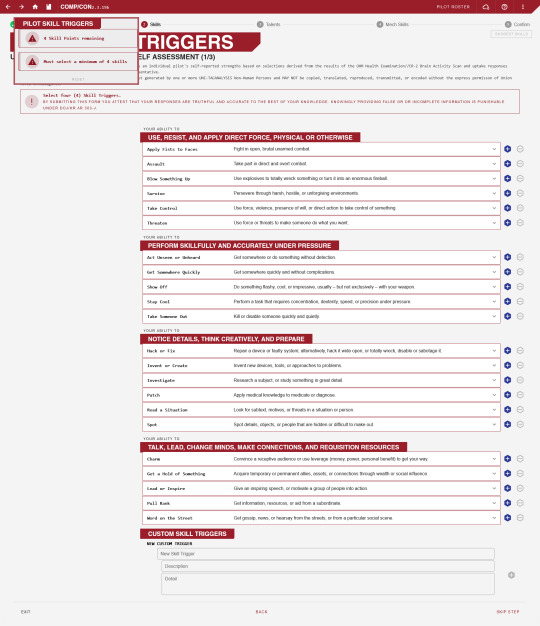
We're brought to a stat creation screen, these don't matter too much in combat, but outside of them they're what your character specializes in, their role outside of the mechs. Don't sweat these too much, you can respect at any level up in lancer, and this won't matter too much outside of on the floor missions, which barely happen

For now, Thracia's good at fighting, investigating, and leading and inspiring, its what she was built for after all!
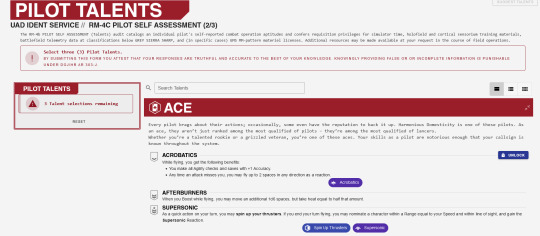
Now we get to talents, these are vaguely intimidating at first glance, but don't worry, you can respec at any time RAW, and they're pretty easy to decode once you get the hang of the system. For now, just think of what your role within the party will be, I want Thracia to be an artillery Pilot with a side of support, so we'll be taking Crack shot (which lets me give up my movement to become better at aiming each turn) , Leadership (which lets me add leadership dice dice to allied rolls as long as my fellow party member is within range) and Technophile (which gives me a Servant-Class NHP, a form of AI that controls my mech if I'm away, not too useful right now, but gets better benefits later on)
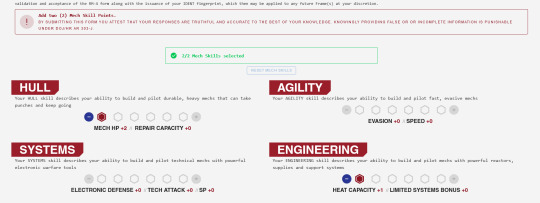
Now we get to the part I don't like, Mech Skills. Mech Skills are... theoretically really fun, but practically speaking you always want at least one level in Hull, and the other level in whatever your main stat is, in this case we'll be taking Engineering, you'll see why later.

Now we have our full pilot card! but there's still a little bit left to do before we Level Up for our first time.

First lets pick out our equipment, this is basically purely flavor so just pick what you think your character would logically have
NOW! we finally get to the fun part: Building your Mech... kinda
see right now, you're stuck with default configurations, you're not licensed for anything more complex than GMS mechs, the Great Value store brand of Lancer. So we carry on with an Everest, a basic if not a bit underwhelming mech, its reliable, customizable, and handy, if not a bit underwhelming and a lot less flashy and optimized than later mechs you get, I'd still keep an everest in your backpocket though, never know when you might need it

Someone playing with all official products would have a choice of 3 different GMS mechs, but I still recommend just picking the Everest, its the handiest option. though for reference: the Chomolungma is a Hacking frame, and the Sagamartha is a tank
You're prompted to name your mech, Thracia's gonna name it A farewell to Arms, after an ancient book she read once

Booting into your mech screen, it may feel a bit overwhelming at first but don't worry, these all aren't too complex to understand
Traits are just that, what your mech has that makes it special from other mechs, its just that genesequouis that makes them cooler than other mechs.
Attributes are derivative stats that take your skills, Grit, and base mech stats into account, in our case the Everest is pretty middling in everything, but has a decent heat capacity due to our investment into Engineering.
and now for the fun bits, Core System and Mounts
Core Systems contain two things: your ultimate move, your signature play, that special power that you use once per duel and spare only for the most dire moments! the other thing is your Core System itself, Everest doesn't have any, but for future reference these are what your build is entirely based around, your core gimmick
Mounts are what you put your weapons into, and Systems are non directly attacking abilities that you use to gain advantage during battles, we once again only have GMS tools to go with for now. Something clever about the mount system is that it adds an inherent balance to mechs, a mech could have incredibly powerful abilities, but lack specific mounts that could make it overbearing, as an example the Gorgon lacks a heavy weapon mount, and Heavy weapon mounts are in general sparsely distributed, as giving them to the wrong mech could break the balance, this is a problem I see a lot of lancer GMs and homebrewers run into, underestimating the power of a heavy slot, even some who were contracted by Massif themselves!

For now, we'll give ourselves a shotgun, to dispatch enemies at close range, a Mortar, to deal with large clusters of enemies, and an Anti-Materiel Rifle to be our primary weapon.
Now for the systems, you have a budget of SP to use on buying systems for your mech from the ones you've unlocked, the GMS systems, outside of some standouts like the Flight System are... underwhelming mostly, you'll usually dumpster these pretty quick, but we might as well pick them because hey, its just free advantage, right?

We'll be mounting our free NHP we got from our talents of course, as well as a shield, a turret drone as we're not doing much with our reactions right now and they allow you to expend a reaction to deal some extra damage, Personalizations and a Custom Paintjob, these are basically just flavor but they both have to do with adding some extra bulk to your mech, in our case the Personalization is a built-in winch, adding a +1 to relevant Hull skill checks, and the Paintjob is a tasteful pin-up of an older looking woman, a fling from a past mission.
And that's it for LL0! It might feel like a lot, but I promise its a breeze in actual play. Now onto:
LL1: Your First Taste of TRUE power
Thracia Schrader Came back to home base, sweaty and tired after a long mission, nothing big, just dispatching some pirates, but it was her first truly serious one, only to receive a ping on her terminal: she'd gotten a promotion, she'd be given budget to buy new parts for her mech, a raised paycheck, and some free time to work on new skills, she was over the moon, finally she'd be getting recognized!
Now onto LL1, so far your mech has had decently high customization, but from here on out? the world's your oyster honey, pull it open and devour its flesh, show the world that it's gotta be scared of you!... I think I lost my train of thought there, sorry about that.

Anyways, when leveling up you'll be given the down-low on what you're getting, an improvement to your skill triggers, more talents, more skills, more grit, your first license unlock, extra sauce on your eggs, and a complementary chocolate bar... OK those last two aren't there, but I'm sure most merc companies add them in
Skills don't matter too much so we'll skip over that, but for reference I took a boost in Leadership

You get an improvement in one talent, in my case I'll take the second tier of Technophile, which lets me reroll one roll per scene, very useful. You can also take a 4th talent at this point, but I recommend holding out a bit before doing that, your build is too weak to really afford big moves like that right now. You could also actually delevel one of your talents and level another to level 3, if you have a talent that you don't really need or want, but again, not recommended unless you know what you're doing

Now onto mech skills, you just get a flat +1 to any skill, right now I'd advise taking whatever you picked as your second skill after Hull, but if you wanna boost hull even further because you don't wanna get hurt too bad, I don't blame you, but we'll be getting that engineering boost for now
NOW to the fun part, the part we're all looking forward to (I think), getting more mech parts! now, people familiar with the system knows that the Engineering boosts and Artillery focus probably means we'll be taking a Harrison license, the 4 licenses in the game correspond roughly to the 4 mech skills in how they're built, they do end up mattering for something called Core Bonuses, but that's for much later, for now just treat them like a way to split playstyles. IPS-N likes Hull, Smith-Shimano Corp likes Agility, HORUS likes Systems, and Harrison Armory likes Engineering, choose accordingly.
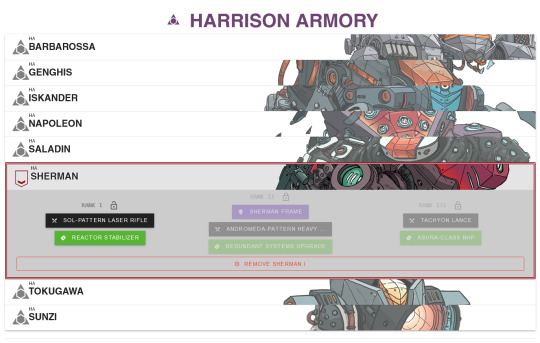
We'll be unlocking the Sherman first, its a cool mech that I think often gets overlooked in this game's cluster fucks of eldritch mecha nightmares and othersuch things. You don't get the mech itself until LL2, so for now just slap on the parts you got into an Everest

The first level up is always kinda underwhelming in lancer, but trust me it'll get better from here! for now, we'll just replace our shotgun with a Sol-Pattern Laser Rifle, and our Personalizations and Custom Paint Job with a Reactor Stabilizer, a useful tool for keeping us nice and healthy when melting down

That's about it for LL1, yeah as I said its kinda boring, but it only gets better with
LL2: You know what they say: Find what your niche is, that leads to riches!
Thracia Schrader comes back home, tattered, bruised and beaten, the promotion obviously meant more dangerous missions, this she knew, but she didn't expect to deal with enemies of that caliber just yet, turns out the pirates were more equipped than she thought at first, they seem too organized to be pirates actually... Well, she's being paid to dispatch rabblerousers, not think, she goes back to sleep in her cot, while browsing mech licenses for sale, she got a big bonus, she can splurge a little bit
While you get the same benefits as from LL1, this is where the fun really begins because if you take a second level from your frame you obtain:
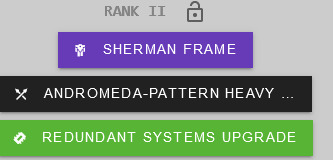
A frame! You can finally get out of that dinky everest and get into something COOL! Frames in lancer essentially serve as your classes, they're what you mount your other obtained abilities into to create your unique playstyle, but overall they're probably the most important aspect of your character. Frames can have different sizes, HP thresholds, armor, and so on. the Frame system leads to your creativity being effectively limitless, while I'm doing a fairly basic artillery build, I'm sure a melee Sherman build could be fully possible! anyways, if you're using this as a build guide for some reason, I took Crack shot and an extra point in Hull alongside the Sherman frame
Now lets build our new puppy shall we?
Our new mech will be called... how about Mr. Blue Sky? its Thracia's favorite childhood song
Now you'll have to rebuild your mech, but with a few considerations in mind
1: Your mounts are all different now, you can't rely on the weapons you did previously most of the time, Sherman's actually an exception to this, it has largely the same mounts as an everest, with the main difference being a built-in laser gun which charges while stabilizing, hm, maybe taking some stabilization talents could be worth the time...
2: Your new mech has new traits! the traits in the everest were pretty simple, just some bonus actions once per scene, "More of what's good" is the unofficial GMS Motto

The sherman's a bit more complex, it can keep you in the danger zone (which benefits not just the sherman but most Harrison Armory mechs really), give you soft cover by throwing steam at your enemy's face, and makes it better at engineering (handy, since you'll be trying your best to not take too much unintended heat)
For equipment, we'll be using some old tools and the new ones we just got

Sherman just got the incredibly powerful Andromeda-Pattern heavy laser rifle, but don't worry kids, this isn't the peak of laser power, oh no no, that comes a bit later. We're also using our handy shotgun, she needs to defend herself from nearby enemies somehow.
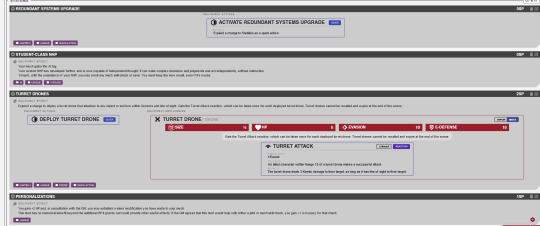
For systems, we're dumping the reactor stabilizer, its served its purpose but we can manage our heat better now, and we're picking up a deployable cover, useful for long drawn out gun fights, personalizations (a huge library of ancient and modern texts, useful for SYSTEMS checks), and turret drones, we're still not doing much with that reaction and our sensor range's pretty dang strong. Now a word of advice, at LL2 is where your build will branch most, you're comitting to an entirely new mech after all! but always remember: you can respec at any time
LL3: True Power!
Thracia comes back home and brews herself a cup of tea, so it turns out that the pirates she was dispatching were just locals defending themselves against the corporate agency paying her, she was offered a contract by them, lower price, but less price on the conscience, she urged her boss to take it, and she did take it in the end, she thanked Christ the Buddha she didn't need to betray the closest thing she had to a family. Tomorrow, Thracia would dispatch a corporate HQ, the locals were calling the Union for aid, and they promised aid would come in the form of supplies, but they'd need to fend for themselves, and supplies did come, she took some of the mech weapon supplies for herself, she was fighting for them now, might as well right?
LL3 is where your chosen frame's power peaks, many people actually skip the third level of a license, the items given are usually fairly niche, we won't be doing that, this is a pretty standard build so i don't think its worth it
you know the drill for skills
Talents, I'll actually do something a bit weird here, if anything to demonstrate one of the more interesting RAW decisions of Lancer, I'll take away crackshot. Most of the laser rifles of the sherman are AOEs, and Crackshot assumes one target. Instead we'll be taking two levels of Grease Monkey, they make our stabilizations stronger, and give us some nice bonuses during rests, and we'll also be capping off Technophile, you'll see why soon.
We'll be leveling up Engineering for this level and taking the final level of sherman, but more on that later because now, we have the first sight of our Core Bonuses
the 5 companies of lancer like to reward brand loyalty, so if you stick with one company for 3 levels, you unlock their "Core Bonuses". what are these? these are powerful abilities that you only get every 3 levels, and you need to have 3 levels in a company to unlock their respective core powers, GMS powers are unlocked by default of course. We'll be taking Superior by Design, the premiere Harrison Armory ability

the boost to heat cap is what we're looking for, anything that makes us less punished for taking too much heat is a good thing. the Impaired immunity is a good bonus
Now at this point, your mech should have unlocked their most powerful weapon and system, these are often "Super Heavy" weapons, which means they take up two slots to mount, but sometimes they just may be a powerful control ability, for example the Kidd unlocks their ability to build misc structures at that level.
We'll be installing our brand new and shiny Tachyon Lance, a massive motherfucker of a weapon that just emits a line of destruction and a cone of destruction behind you

we'll also keep the shotgun, its a handy weapon
for systems, we'll be equipping our brand new Asura-Class NHP, what does it do?
well, once per scene, it just lets you take another turn! No caveats, and the only real cost is a bit of heat on your end, but other than that? you just have two turns that turn, incredibly valuable in a build that often wants to stabilize, wasting precious actions
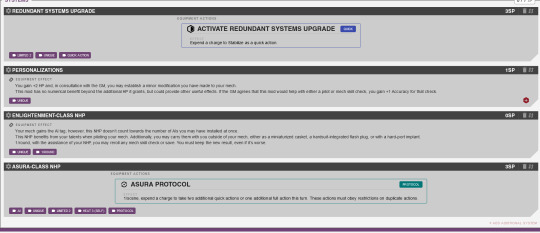
Oh, as for the third level of technophile? I can't have 2 NHPs in a mech at once unless I take that level, its just not possible, NHPs are incredibly powerful resources so I understand wanting to limit them like that.
That's about it for LL3, its your peak of power... for now, but soon enough your mech might be having some... foreign intrusions
LL4: The Crossover nobody wanted
Thracia was broken. She wished she'd never signed up for this mission in the first place. Children and women running from corporate mechs way better equipped than them, farms being abandoned by people who lived there for generations, good people sacrificing themselves to keep their loved ones safe. Terrakis had gone from a quick buck by dispatching pirates, to a nightmare. She was always told it was a dirty business, making money from blood, but she never expected it to be this bad. Looking to calm down, she calls up a friend, a warehouse worker from IPS-N, and wonders if she could maybe hook her up with something
You know the drill by now, the only thing of note is I'm going to dump Leader to take 2 levels in Siege Specialist (lets me take down structures more easily and lets me knock down adjacent enemies), we're picking up another level of Hull, and now, for the interesting bit: your 4th license
At this point, you've found your niche and made your mech plenty strong... but it could always be better, right?
Thracia picks up a level of the Drake, giving her the powerful Assault Cannon, a handy, if not low ranged, weapon that can grow in strength by spinning its barrels before launching, as a bonus its also a cannon allowing for our Siege Specialist to trigger. She throws away her nostalgic shotgun for this weapon

Thracia had also been feeling protective of her fellow backliner, a clumsy goblin pilot named Lika whom she borderline had a crush on, while Thracia's mech isn't bulky by any means, its bulkier than xer goblin, so she gives up her redundant systems to pick up the Argonaut Shield, a tool that lets her take half the damage her fellow pilot would take instead.

Conclusion: You got your tools now!
Thracia was tired of seeing people dying, she was tired of the war, of the bastards in suits puppeteering it, she wanted it done and she wanted it done now. Talking to the leaders of the locals they decide on a final plan of attack: destroying the HQ of the corporate settlers
SimpleCorp must fall
Terrakis must be free
From here on out, you have your own tools to make your own builds, remember to focus on your roles, pick up abilities that complement your allies' playstyles and positionings, and most of all: have fun! a bad build in lancer isn't a huge deal, you can always try and try again until you get it right.
Oh, you wanna know how Thracia's story ended?
Alright then, here you go
Mr. Blue Sky stood atop the ruins of SimpleCo's elite pilot: Fear, Thracia was no longer afraid, she was no longer broken, she was now only filled with pride, and joy. Terrakis was free, and she had been a part of its liberation. She hoped this would send a message to any bastard trying to take it over, she looks upon the pictures hanging inside her cockpit, complimentary drawings given to her by small children, of her mech as a hero of legend, of SimpleCo goons being burnt by her Tachyon Lance. That day, Thracia knew she had for once in her life done the right thing. After all of this, she decided to stay, War was not her business, and the locals of Terrakis wished for her to stay to help with any future intrusions.
She and Lika lived a peaceful life together, no one wanted to fuck with Terrakis after SimpleCo's downfall
Too cheesy? well, sometimes that's just how careers end, in the duty of a lancer, you either leave before you die, or you die before you leave. Go play your own stories! I'm sure there's some GM out there struggling to find new players who'd love to have you in their group
oh fuck i completely forgot to talk about bond-
21 notes
·
View notes
Note
Hi! I just saw in one of your posts you mentioned that in D20 they sometimes do multiple takes, which is very interesting to me! Did they give any context around when that's most common--like for a reaction to plot stuff vs a roll? I'm neither here nor there about the multiple takes bc tbh if that's how they're doing it that's how they're doing it, but I'm curious to know how they spoke about it.
The only one I'm actually definitely aware of is that the initial introduction for Saccharina in A Crown of Candy came earlier, and they decided it made for a weird ending and story so they decided against it but they lost the video of the original ending and only had the audio, hence that episode that ends with an illustration of Amethar carrying Jet's body with audio overlaid. I don't know how often this happens more generally and I suspect they don't do it terribly often. I'm not an actor but I think a big part of actual play is the "actual" part; you don't want to fake a reaction and you don't want to fake a roll. As you can see, this example was purely a plot decision and one made by the GM and player and not the characters.
I think the bulk of D20 editing is just normal editing choices that podcast actual play had already been doing for years (cutting out extended rules discussions and clarifications or actors trying to add numbers together, or people really flubbing a line in a way that isn't necessarily funny or which kills the vibe). I don't think they actually run multiple scenarios often; only that technically, they have at least once.
21 notes
·
View notes
Note
this ship and fandom has not died i discovered this ship a while ago and im obsessed. Also have you seen that in the wiki wu has a cousin named shihan who is dean of republic city university.
This ship is still afloat! I'm doing my best to keep it alive haha but I can't do it without you guys!
I did actually talk about Shihan in a post here:
She is introduced in the newest book for the Avatar Legends tabletop roleplaying game. The book is the Republic City Setting Toolkit, and it has a ton of delightful information about the city and all the people within it.
Shihan is described as a vivacious woman and she is Wu's 'distant cousin', which upon googling the definition of 'distant cousin' is, at a minimum, a third cousin-once removed. I've personally headcanoned that she is a 4th cousin once removed, and that her family branched off before the ruling of Kuei.
She also helps Wu write policy for his plans to democratize the Earth Kingdom, which I think is a fun way to keep Wu coming back to Republic City often (and spend some time with Mako too..?).
And, the book also confirms that Wu went to school at Republic City University, so Wu, at some point, was going to school that was run by his (distant) family member. Nepotism? Idk. Lots of fun things to play with if you want include Shihan in your headcanons and fics!
15 notes
·
View notes
Note
stumbled across some of your posts about a code lyoko ttrpg
i am interested please tell me more 😭
ive been wanting to run code lyoko dnd for so long but i dont have the smarts to change dnd to make it feel code lyoko
Hey there! I'm super excited that someone's interested in this because it's such a passion project of mine haha, I'm sorry in advance if this answer is more than you bargained for!
To give you the rundown, I ran a very brief and experimental dnd 5e hack for Code Lyoko a couple of years ago for some friends. It was a lot of fun, but the system was SO badly Frankenstein'ed that we ran into a lot of technical issues, especially regarding the Lyoko/reality split and how it effected different builds. The old guide for that hack can be found here for free, but please take note that it is very informal and poorly optimized!
Recently though, I've been experimenting with non-dnd systems and building my own tabletop games, which is where Warriors of Xanadu comes into play. (This might get lengthy so feel free to skip to the TLDR.)
Warriors of Xanadu is a code-lyoko/garage-kids inspired system that I'm working on myself with the help of a few more experienced friends. It's built off of the Apocalypse World framework (basically a 2d6 system–if you've played Monster of the Week, Masks, or Avatar: Legends, think something like that) specifically designed to work well with the world and story CL provides. That means all the gameplay mechanics are inherently relevant to running code-lyoko-inspired adventures and there's no extra work to be done on your part. It's also a lot easier to teach/learn than something like DnD. (Even the character sheets are designed to be accessible so players could technically make their character with just their printed-off sheets and no additional resources! Much easier than dnd.)
Each non-GM player plays as a "Hero" and chooses a unique combination of a playbook (centered around academic character tropes like cool kid, geek, class clown, etc.) and a class sheet (how they appear on "Xanadu," with options like rogue, mage, warrior, etc.). Then, In-game, heroes go through episodic challenges where they encounter problems in reality caused by "the Virus," and must transport themselves to Xanadu to combat it. There's also a handful of original mechanics relating to social/academic rapport, corruption from the supercomputer, etc. The health/harm system and combat is inspired by Apocalypse World and Monster of the Week, and is meant to inspire a more survival/horror element than what something like dnd would provide. (Essentially the goal is not to engage in and "win" lengthy combat encounters, but to stay alive and usually avoid enemies when possible.)
I feel it's also important to note that it's not 1:1 Code Lyoko; it's very transformative and a handful of ideas are heavily abstracted to be more fun in a ttrpg setting. It's open-ended and customizable enough that you could technically run an unrelated story with it. That also means that there's some fun surprises for folks familiar with Code Lyoko, though, and you could still run something close-to-canon if you wanted.
The first draft of WoX is about 60-70% completed, I just need to finish the GM-heavy parts of the manual, finish some of the moves, and actually put together fillable playbooks/class sheets. I'm hoping to have it completed and ready to playtest by the end of the summer, but that's a loose deadline. Once I've done some playtesting and gotten feedback from others, I'll probably release the first public version on drivethru rpg and/or itch.io as a free or PWYW sorta deal.
TLDR; Warriors of Xanadu is a powered-by-the-apocalypse style trrpg system I'm working on. It's made from the ground up to support a Code Lyoko inspired campaign. I'm almost done with it but still have some work to do!
If you're comfy coming off of anon, I'd be happy to make note of you and send you the playtest version when I'm done with it, or answer any additional questions! (Same goes for anyone else reading this!)
#code lyoko#garage kids#nyklos is typing#wox ttrpg#sorry this is a lot I just love talking shop about ttrpgs and I never have a chance to tell people about WoX
20 notes
·
View notes
Text
Narcissist: Antedesertium
Narcissist: Antedesertium, Aetherco, 2006?
Narcissist is a dimension-traveling game that revolves around a central timeline, ostensibly our own world. Your characters ("Drifters" or "Crashers") skip in and out of that timeline, creating new worlds in an attempt to generate the perfect one they want. You can find my review of Narcissist back in mid-November 2023.
The future of the central timeline is home to the Inheritors, post-human people with advanced technology and incredible psychic power. In its past, from the years of about 18,000 BC to 14,000 BC, is a period known as Antedesertium. This era is home to the Inheritors' opposite numbers: the Kings of Yrnë.
The Inheritors seek to preserve the central timeline, apparently successfully. The Kings of Yrnë seek to splinter it, a task at which they eventually fail. There are millions of Inheritors; they may actually compose the majority of living beings after the Hour of Inheritance (sometime around 2221). There are twenty Kings of Yrnë. The Inheritors look like "grey" aliens, but still basically humanoid. The Kings of Yrnë look like nothing that was ever remotely human - and yet each of them once was.
The Antedesertium supplement for Narcissist details the era when the Kings of Yrnë ruled the world. It describes the Kings themselves, the non-dimension-traveling people of Yrnë, and the many forking timelines that clutter these four thousand years. It's an incredibly chaotic period. The farther downstream (into the future) one goes, the more overlapping, shattered worldlines stack up upon one another, until the Interregnum, when a massive explosion shifts the Earth's axis and turns the Sahara into a desert.
The descriptions of the Kings of Yrnë set them up as driving forces for the game, the same way that 13th Age does with its Icons or Exalted does with the Deathlords. Seven of them get multi-page writeups of their personality, powers, goals, and supporting characters. The rest get about a half-page each. The people of Yrnë get a 20-page chapter, which honestly feels a little short to cover 4000 years of history. Three main time periods are covered: the rise of the Narcissists when the Kings were still honorable, the turning point when things start to go wrong, and the chaotic end-times before the Interregnum. The book does a good job of not falling into the usual tropes one sees depicting Africa and/or prehistoric times. People are described as, well, people, rather than as animalistic idiots.
Art and layout are very similar to the rest of the books in the series. Each King gets an illustration, some of them simple and concrete (a black dome), others abstract and confusing. It's serviceable.
The best part of Antedesertium is that it's full of plot hooks. There are over a hundred mysteries, side characters, cool moments, and whims of the Kings that could provide grist for the adventure mill. The weak part is that there isn't much that ties them together. The book seems to assume that the GM will be creating antagonists using Span 4 or 5 characters from Continuum. I suspect a lot of games will pit a group of Narcissists against the servants of other Kings in an attempt to bend the timeline to their will, rather than protecting Yrnë from its actual enemies. Still, I'll take 100+ plot hooks over the one half-baked adventure that most games have. The best piece of GM advice it gives is that most of the inconsistencies in the book are intentional. In a game like Narcissist, every plot hole is a plot hook.
My copies of Narcissist and Antedesertium arrived unexpectedly in the mail quite a while back. I still haven't found any reputable sources for physical or PDF copies of the books, but I'll keep looking.
#rpg#indie ttrpg#imaginary#ttrpg#crash free#still haven't figured out where these stamps are from#review
8 notes
·
View notes
Note
Have you learned any new fun facts about cars recently?
Of course!!!
Just today:
I learned that the Golf Country (wicked factory off road version of the Mk2 Golf) was lifted over 4 inches for a total of around 7 inches of ground clearance!


I learned the absolutely mental Cobalt SS was essentially a parts bin special -they had a powerful 4 cylinder from the Saturn Ion Red Line and figured they'd put it in the less weird Cobalt and people would care, which they did- and that its epoch-making 260hp powertrain was only a later upgrade -again, borrowed from another car, the Pontiac Solstice GXP- once the original engine no longer met emission requirements. And that it had a sedan version!!!


And, while writing this post, I looked for details on how this lapped the King-Daddy, longest and most gruelling monster of all circuits that is the Nürburgring faster than the all-wheel-drive six-figure Japanese demigod that is the Skyline GT-R, and found out about the popular misconception that this refers to the R34 Nissan Skyline (right), to date the most coveted and sought after, whereas it actually refers to the R32 (left), a prior version -though not much less groundbreaking in its own time- and that the nonetheless staggering feat may largely be attributable to tire formulations having vastly improved between 1990 and 2008.


I learned of the Ford Transit Sportvan, a confusingly diesel sporty? version of the Ford Transit!


Hell, I learned about a small 20s brand I didn't even know existed!
I find out new things about cars every week, and that's not every day just because most days I run out of time to read and listen and browse all the car-related content I would want to (hence me writing this at 2:30AM, cough cough). Every model has an intricate story usually originating years before its birth, thousands of parts, usually dozens of variations year over year, mountains of media created around it and thousands of examples that have gone around to be featured in movies, owned by celebrities, and participate in history in other thousands of minuscule little ways. Multiply this for thousands of models worldwide and then multiply that for a century and a half. However narrow your area of interest, if you think you know as much as most of the car trivia within it you are absolutely a fool.
Oh wait you were probably asking for an actually fun fact.
Oops.
Well, still today, I learned that our dear Saturn Vue, remember our dear Saturn Vue? Well, not @makenoplans's, the second generation, it turns out that 1. at fucking least it drove well and 2. it died along with Saturn itself when GM went bankrupt and a clause stipulated for the government bailout was to kill three of its brands - Saturn being one of their least successful at the time I WONDER FUCKING WHY I WONDER IF THERE WAS ANYTHING ONE COULD HAVE DONE TO SAVE IT LIKE NOT EVISCERATING ALL LIFE OUT OF IT AND TURN ITS CORPSE INTO AN AMERICAN DISTRIBUTOR FOR A MEDIOCRE GERMAN CAR BRAND i am calm i am calm i am digressing. Well they'd relatively speaking just started making the second gen Vue in Mexico and they were like aw cmon do we really have to stop selling it so soon? And so they just fucking. Used the "Chevrolet Captiva Sport" branding it was sold with in South America to sell it to rental companies. It's basically like a fake ID but it's no faker than the one you started off with.
Oh! And a bit less recently I found out that bafflingly you could get the first generation Honda Civic with three different trunk doors - seen here in increasing order of price and sense.

#saturn vue#chevrolet captiva sport#vw golf country#chevrolet cobalt ss#saturn ion red line#nissan skyline r34#nissan skyline r32#ford transit sportvan#honda civic
12 notes
·
View notes
Note
Could you talk more about the different reasons you think Taylor should have been in Ward?
It's. Complicated. and I think the whole question of where Taylor should have been post-worm is pretty personal and subjective. Long deranged post below cut.
Taylor's post-worm fate has changed multiple times, going from:
Taylor is alive and on a world without powers, which is a metaphor for heaven (Worm epilogue).
Taylor is Literally dead, and in some kind of heaven (wilbow on various forums).
Taylor's fate is "meant to be ambiguous" and "what you want/need it to be", whether that means a alive, in a coma, dead, or whatever (wildbow on reddit).
Taylor is "gone", and is no longer part of the story. Her fate is ambiguous apart from the reading where she is still with the undersiders (Glow-Worm, Ward).
I can kind of see the logic behind this (wildbow was trying to appease everyone at once, and was later trying to make space for Victoria's story), but at the same time it's incredibly frustrating. Especially for Ward, her being "gone" very much feels like she 100% was killed off. She is less present and active than people who definitely canonically died. She is "narratively dead".
So I guess a lot of the "I wanted Taylor to be in ward" desire is basically just a "I want Taylor to not be dead" desire? Maybe?
Which is a weird thing to articulate. Maybe it's more useful to look at the reasons people want her to be dead or like the idea of her being dead, and why I don't agree with them;
"Taylor losing her powers or dying is form of narrative punishment."
I think I was maybe more comfortable with this idea when I first read worm 7 years ago, before I read ward.
However, ward reframes this, as the story conflates narrative punishment/justice with in-universe justice. It's hard to get behind the idea that Taylor should be "punished" by the story because the the final beat of Rain's arc is that he is punished by both the story and the Gimel judiciary system (as much as they have one?), with this being framed as a good thing.
It's like, I can't uncouple narrative judgement and in-universe legal judgement anymore, because ward very much frames them as same thing.
"Doing weird Panacea brain surgery to yourself should have consequences and weight."
This one makes a lot of sense- if a character takes an important, risky action/choice, that action should have "weight" to it. It should have staying power in the story outside of questions of moral judgment.
The issues I have here are that;
A: I don't think that it's well established that becoming Khepri was that much of a risky or irrevocable move? It's certainly not unique or peerless. The brain issues and inability to recognise others appears before in the S9 arc and is cured there. There are also implications at the end of Ward that the Titans can be cured or returned to normal/resurrected. Kenzie's dream box, Teacher's experiments, the stuff Cryptid does... there's just, so many similar things that just don't have the same weight to them, but which are similarly risky and dangerous in-universe.
B: I don't think that the story as it stands, with Taylor being dead, does treat Khepri as something with weight and staying power? Basically every cape group in existence has a reason to be mad at Taylor, and, by extension, the undersiders, but this never seems to matter or be extant in ward? Similarly Taylor being healed off-screen or dying as a way to deal with her memory issues feels like a huge cop-out. I would have loved a background thread of Taylor having to re-learn to speak and read, and re-learn how to be a person. I would have loved to see her painfully and gradually heal. I would have loved the aftermath of GM to actually be difficult.
"Taylor is a fundamentally self-destructive person, and GM/Khepri was an act of suicide."
This is probably the idea that I have the most trouble with.
There's a lot of personal stuff I could talk about here, and without getting to deep into it, a big part of this is that I don't think that I'll ever be able to enjoy a character arc that boils down to "this girls gets traumatised by bullying, so she becomes self-destructive and eventually kills herself".
Taylor obviously is self-destructive and (in a sense) suicidal, but if the end of the story is framed like that then it's not something I'm equipped to enjoy or find properly impactful.
However, there's a less personal, more nuanced problem here, which is that I think that this take on Khepri describes Taylor as an incredibly static character, who can't heal, and/or is unable to heal?
Or, put another way, if Taylor is a character who is fundamentally unable to change or heal, I don't think that worm takes the the time to explore this (what happens when she tries to heal/change, etc) well enough. This reading doesn't say anything, it doesn't feel earned, and it robs her of agency in a weirdly lazy way.
(having a small amount of time in ward would allow for some of this exploration, and ask questions about who she is when there isn't constant major threats to react to, or without the apocalypse breathing down her neck, etc.)
Anyway. Again, it's a very subjective topic, and here are probably some perspectives I haven't considered, but these are just my takes on the matter (or some of them anyway).
#sorry this is like#a week late lol#i'm kind of scared going into this much detail with this will like#out me as some kind of 'weird opinion haver'#but then again maybe everyone who reads worm has at least some weirdo opinions on it
31 notes
·
View notes